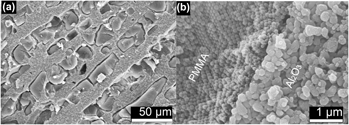Crossref Citations
This article has been cited by the following publications. This list is generated based on data provided by
Crossref.
Porter, Michael M.
Mckittrick, Joanna
and
Meyers, Marc A.
2013.
Biomimetic Materials by Freeze Casting.
JOM,
Vol. 65,
Issue. 6,
p.
720.
Deville, Sylvain
2017.
Freezing Colloids: Observations, Principles, Control, and Use.
p.
549.
Deville, Sylvain
2017.
Freezing Colloids: Observations, Principles, Control, and Use.
p.
253.
Deville, Sylvain
2017.
Freezing Colloids: Observations, Principles, Control, and Use.
p.
439.
White, Mary Anne
Conrad, Jacy
Ellis, Sarah N.
and
Chen, Ran
2017.
Investigations of ice‐structuring agents in ice‐templated ceramics.
Journal of the American Ceramic Society,
Vol. 100,
Issue. 11,
p.
5066.
2018.
Ice Templating and Freeze‐Drying for Porous Materials and Their Applications.
p.
177.
Yang, Xutong
Liang, Chaobo
Ma, Tengbo
Guo, Yongqiang
Kong, Jie
Gu, Junwei
Chen, Minjiao
and
Zhu, Jiahua
2018.
A review on thermally conductive polymeric composites: classification, measurement, model and equations, mechanism and fabrication methods.
Advanced Composites and Hybrid Materials,
Vol. 1,
Issue. 2,
p.
207.
White, Mary Anne
Conrad, Jacy
Chen, Ran
Romao, Carl
Pereira, Anderson
and
Hill, Ian
2018.
Applications of ice‐templated ceramics.
International Journal of Applied Ceramic Technology,
Vol. 15,
Issue. 5,
p.
1075.
Scotti, Kristen L.
and
Dunand, David C.
2018.
Freeze casting – A review of processing, microstructure and properties via the open data repository, FreezeCasting.net.
Progress in Materials Science,
Vol. 94,
Issue. ,
p.
243.
Ellis, Sarah
Romao, Carl
and
White, Mary
2019.
Near-Zero Thermal Expansion in Freeze-Cast Composite Materials.
Ceramics,
Vol. 2,
Issue. 1,
p.
112.
Seuba, Jordi
Maire, Eric
Adrien, Jérôme
Meille, Sylvain
and
Deville, Sylvain
2021.
Mechanical properties of unidirectional, porous polymer/ceramic composites for biomedical applications.
Open Ceramics,
Vol. 8,
Issue. ,
p.
100195.
Noël, John A.
and
White, Mary Anne
2021.
Freeze-cast form-stable phase change materials for thermal energy storage.
Solar Energy Materials and Solar Cells,
Vol. 223,
Issue. ,
p.
110956.
Shiverskii, Aleksei V.
Owais, Mohammad
Mahato, Biltu
and
Abaimov, Sergey G.
2023.
Electrical Heaters for Anti/De-Icing of Polymer Structures.
Polymers,
Vol. 15,
Issue. 6,
p.
1573.
Mahmoodiyan Najafabadi, Fereshteh
Karbasi, Saeed
Benisi, Soheila Zamanlui
Shojaei, Shahrokh
Poursamar, S Ali
and
Nasr Azadani, Reyhaneh
2023.
Evaluation of the effects of alumina nanowire on 3D printed polycaprolactone / magnetic mesoporous bioactive glass scaffold for bone tissue engineering applications.
Materials Chemistry and Physics,
Vol. 303,
Issue. ,
p.
127616.
White, Mary Anne
Kahwaji, Samer
and
Noël, John A.
2024.
Recent advances in phase change materials for thermal energy storage.
Chemical Communications,
Vol. 60,
Issue. 13,
p.
1690.





